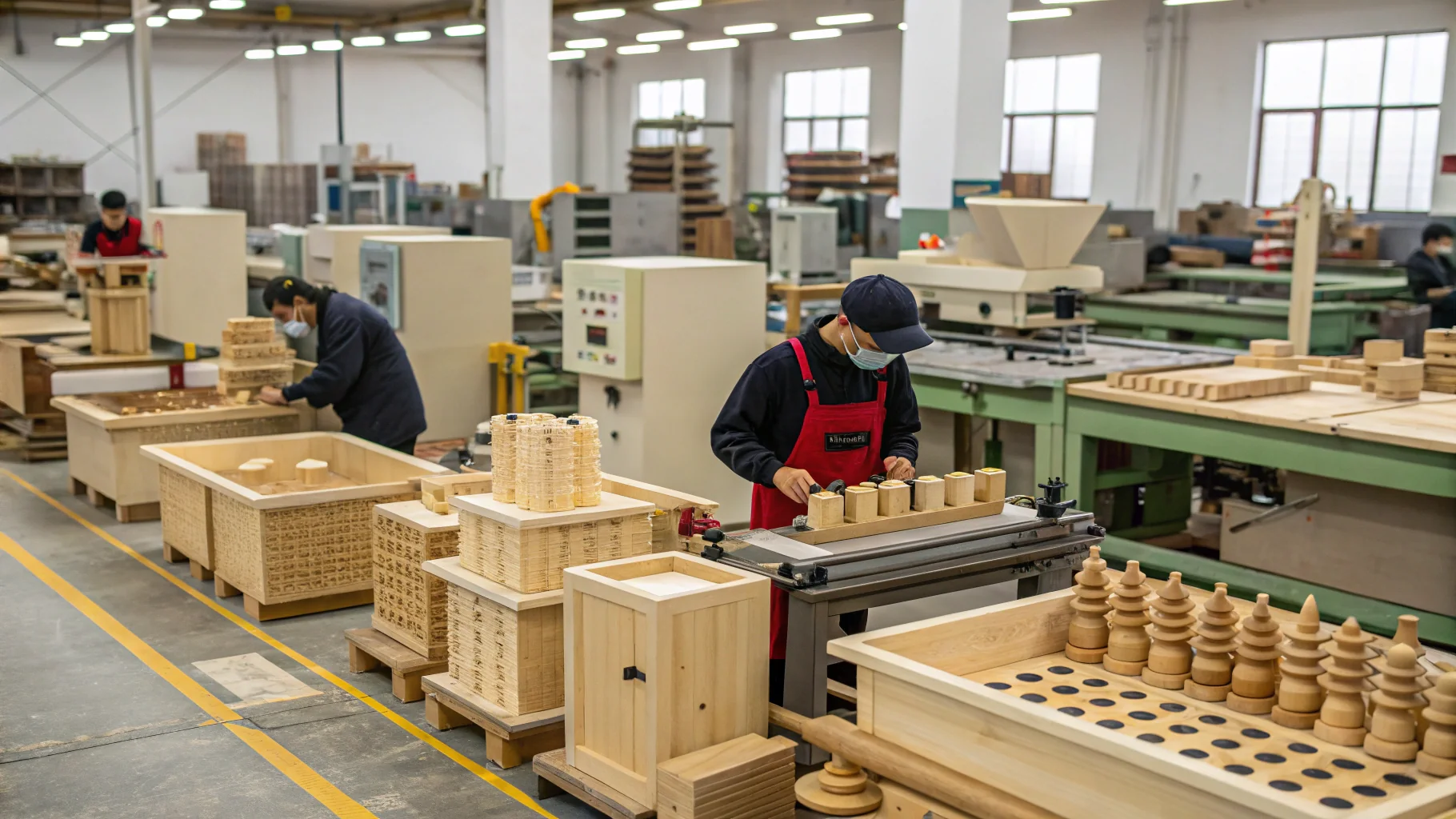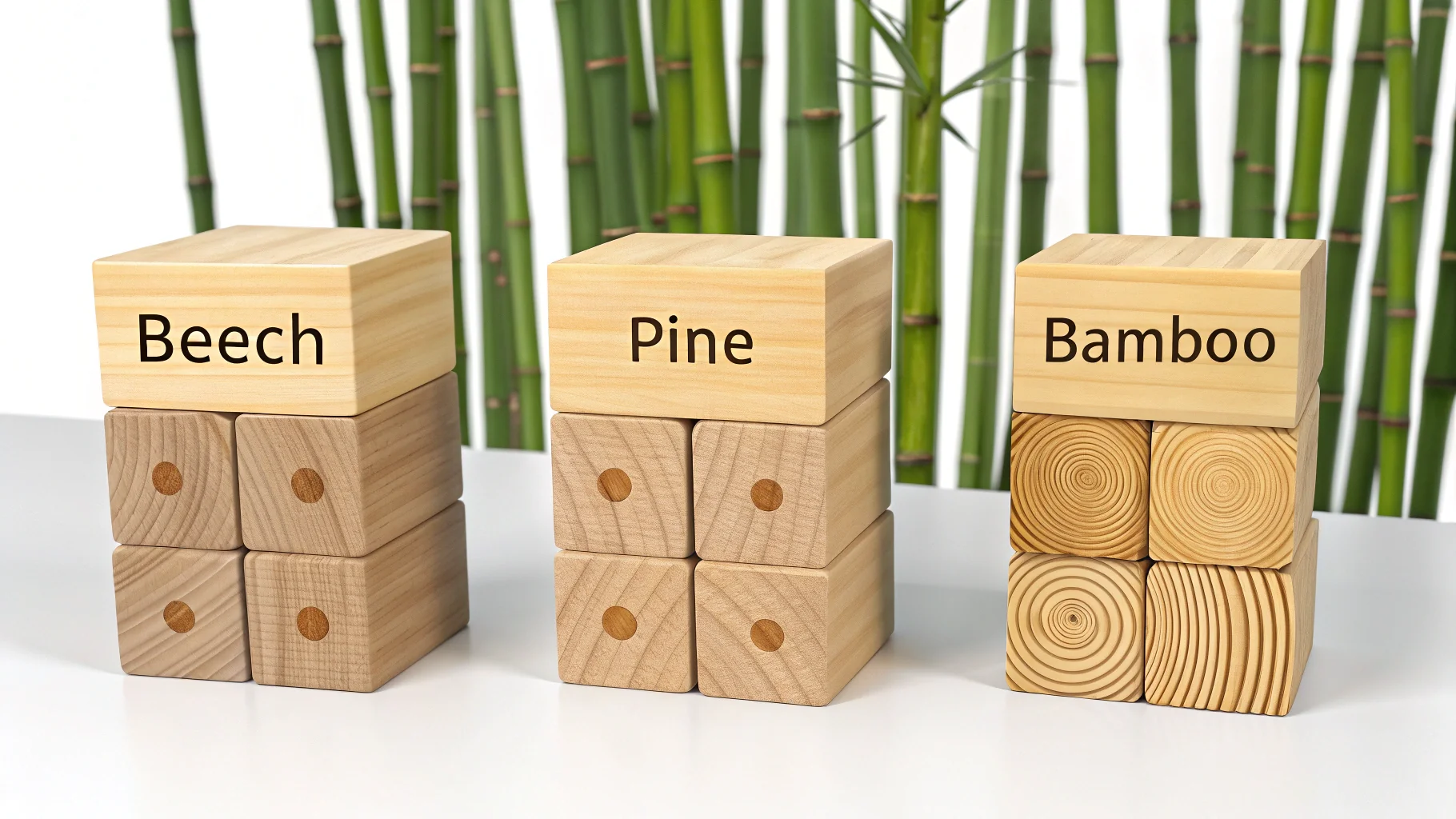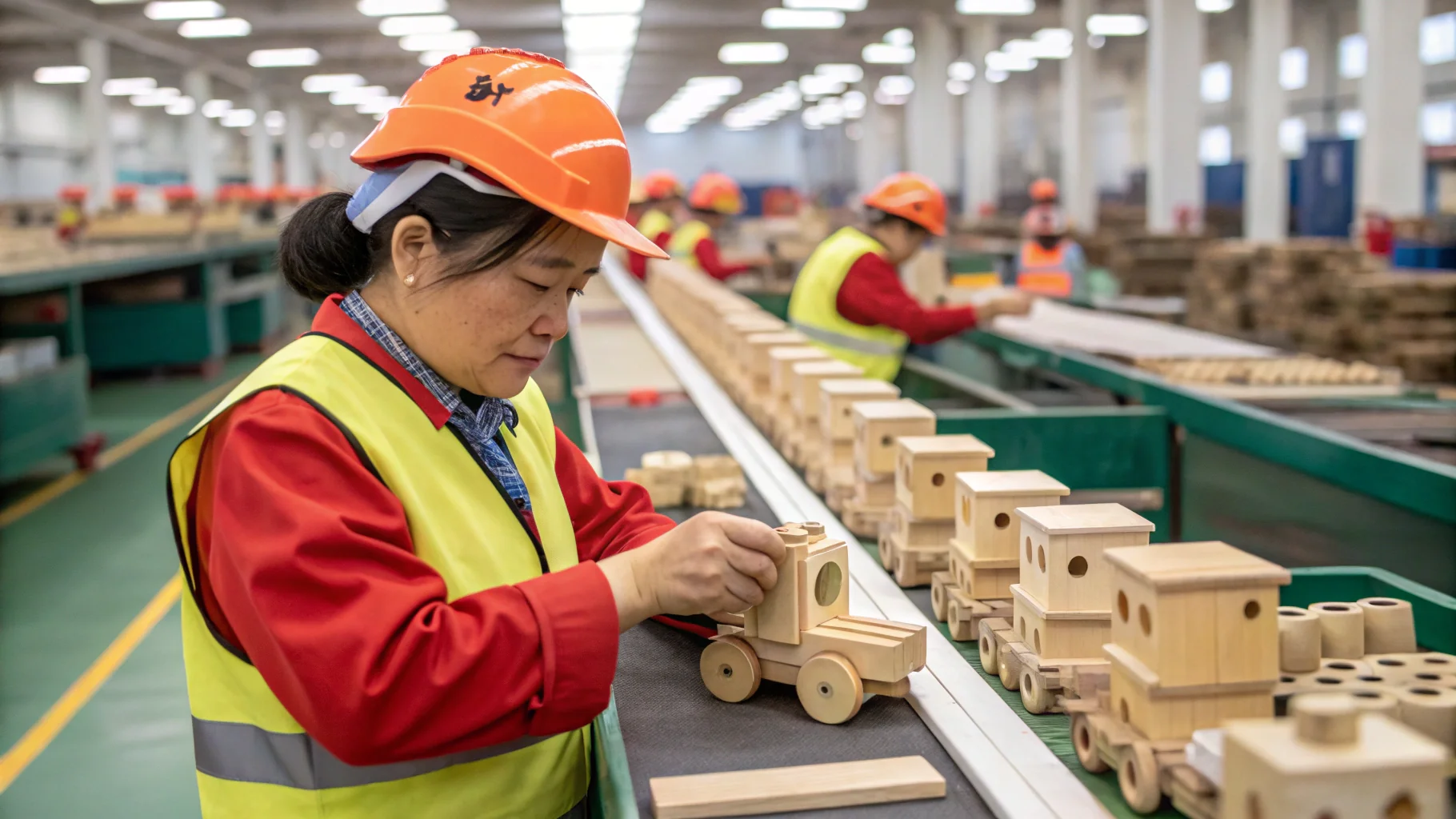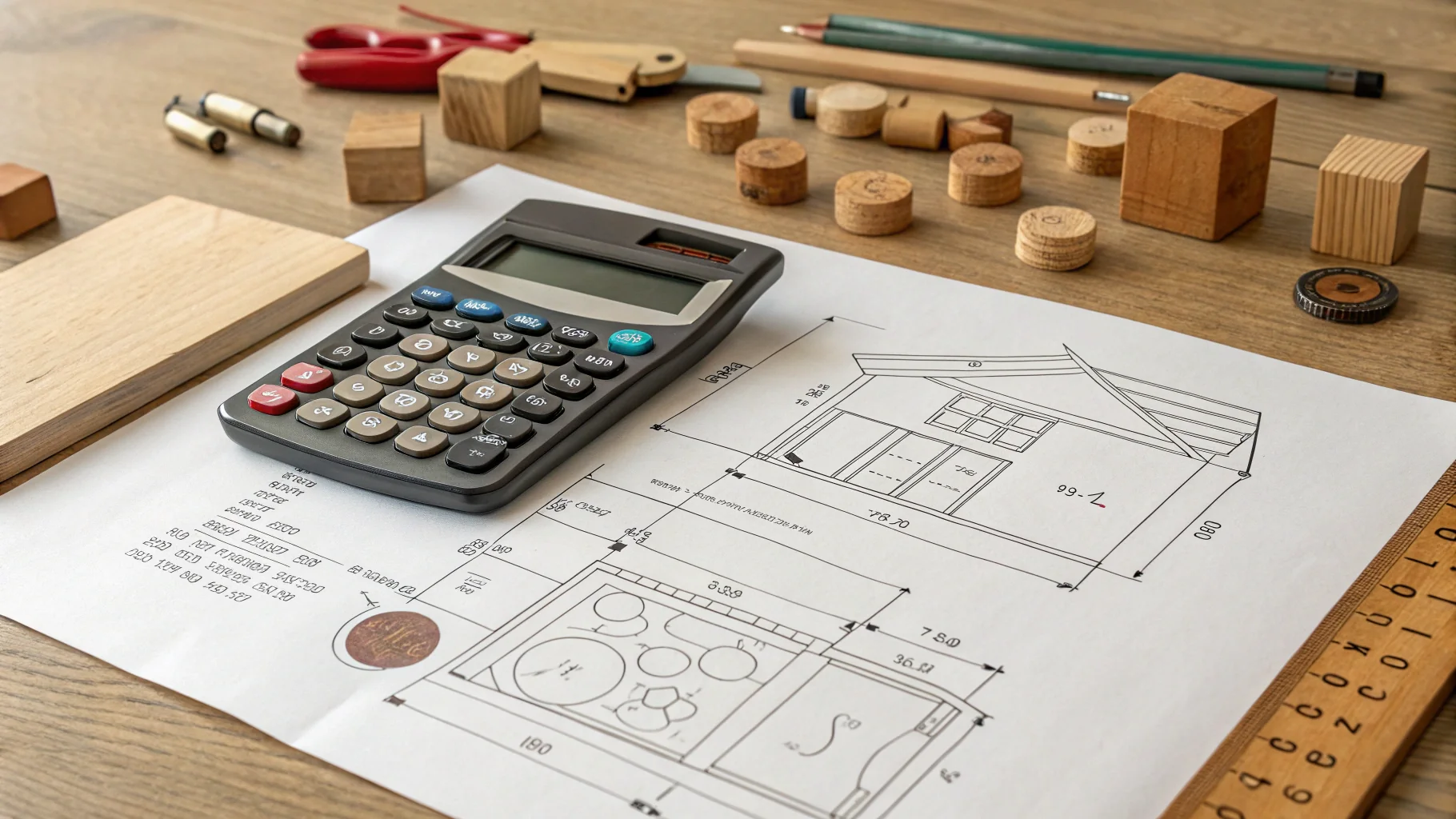How Can You Navigate the Custom Wooden Toy Market in China?

Thinking about custom wooden toys[^1] but unsure where to start in China? Sourcing from afar can be risky, but I'm here to share my insights to help you succeed.
China's custom wooden toy market is a global leader, driven by vast manufacturing capabilities and a growing domestic demand. Key success factors include finding reliable suppliers[^2], understanding material choices, and navigating production logistics to ensure a high-quality, safe, and cost-effective product.

I started my journey in the mold industry, but my CNC trading company opened my eyes to other manufacturing methods. I saw many clients, just like you, exploring materials beyond plastic. Wood, with its timeless appeal, is a fantastic choice. But sourcing wooden products, especially toys, has its own set of rules. It's not just about the design; it's about safety, materials, and finding the right partner. The global wooden toy market is growing fast, fueled by parents who want sustainable and educational products for their kids. This trend presents a huge opportunity for designers who know how to tap into it. Let's break down what you need to know to master this process.
The global wooden toy market is projected to reach over $28 billion by 2028.True
This growth is driven by a rising consumer preference for sustainable, eco-friendly, and educational toys over plastic and electronic alternatives.
All wooden toys from China are made from bamboo.False
While bamboo is a popular and sustainable option, a wide variety of woods like beech, pine, and rubberwood are commonly used. The choice depends on the toy's design, durability requirements, and budget.
What Are the Best Wood Types for Your Custom Toy Designs?
Choosing the wrong wood can ruin a great toy design, leading to breakage or safety concerns. Imagine your product failing safety tests because the material wasn't durable enough.
The best woods for custom toys in China are typically hardwoods like beech and rubberwood for durability, and softer woods like pine for cost-effectiveness. The choice depends on your budget, design complexity, and required safety standards[^3]. Bamboo is also a popular sustainable option.

When I work with clients on CNC projects, the first conversation is always about materials. It's the same for wooden toys. The material you choose affects everything: the look, the feel, the durability, the safety, and of course, the cost. A designer like you needs to know the pros and cons of each option to make the right call. It's not just about aesthetics; it's about how the wood behaves during manufacturing. Some woods machine beautifully, holding sharp details, while others are prone to splintering. Let's look at the most common choices you'll find when sourcing from China.
Hardwoods: The Premium Choice
Hardwoods like beech and maple are my top recommendation for high-quality toys. They are dense, strong, and have a fine grain. This means they are less likely to dent or splinter, which is a critical safety feature for toys. From a manufacturing standpoint, their density allows for very precise CNC machining[^4], so you can create intricate designs with crisp edges. They also take paint and finishes very well. The downside is cost; these are premium materials.
Softwoods: The Budget-Friendly Option
If you're working with a tighter budget, softwoods like pine are a viable alternative. Pine is lightweight and much less expensive than hardwoods. However, it's also softer, meaning it can dent and scratch more easily. This makes it better suited for items like building blocks or toys that don't have small, delicate parts. You have to be careful during manufacturing to avoid splintering.
Engineered and Sustainable Woods
Plywood, MDF, and bamboo are also very common. Plywood is strong and stable, great for puzzles or playsets. Bamboo is a fantastic sustainable choice. It's technically a grass, but it's as hard as some hardwoods, grows incredibly fast, and is very eco-friendly.
| Wood Type | Durability | Cost | Best For | Manufacturing Notes |
|---|---|---|---|---|
| Beech | High | High | High-end toys, detailed parts, teethers | Excellent for CNC, holds fine detail, smooth |
| Pine | Medium | Low | Blocks, simple shapes, budget items | Prone to dents, requires sharp tools |
| Bamboo | High | Medium | Eco-friendly toys, flat items, puzzles | Can be hard on tools, sustainable |
| Plywood | High | Medium | Playsets, puzzles, larger structures | Edges need finishing to look good |
Beechwood is often preferred for high-end toys due to its hardness and fine grain, which resists splintering.True
This physical property makes it safer for children and allows for more detailed and durable designs compared to softer woods like pine.
All wood used in Chinese toy factories is sourced locally from China.False
Many reputable manufacturers import specific woods, such as European Beech or North American Maple, to meet the quality specifications and preferences of international clients.
What Challenges and Opportunities Await When Sourcing Wooden Toys from China?
Sourcing from China offers huge cost benefits, but the risks can feel overwhelming. Communication gaps, quality control[^5] nightmares, and complex regulations can derail your entire project and budget.
Key challenges include quality control, communication barriers, and ensuring compliance with international safety standards like ASTM F963. However, the opportunities are immense: unparalleled production capacity, cost-effectiveness, and access to a skilled workforce, offering a significant competitive advantage.

I've built my business by bridging the gap between Western clients and Chinese manufacturers. I've seen the frustrations, but I've also seen the incredible successes. The key is to go in with your eyes open. China's manufacturing ecosystem is a massive opportunity. You have access to skills, machinery, and supply chains that are hard to find anywhere else. But it's not a simple plug-and-play system. You have to actively manage the process. I remember a client who was about to give up after a bad experience with a supplier. We worked together to find a new partner, set clear expectations, and put a simple inspection process in place. That client's business is now thriving. It's about turning potential problems into a structured process.
Challenge: Quality and Safety Compliance
One of the biggest fears is receiving a shipment of toys that don't meet quality standards or, even worse, fail safety tests. Regulations for children's products (like paint toxicity and small parts) are extremely strict.
Opportunity: Reputable Chinese factories are well-versed in international standards like EN-71 (Europe) and ASTM F963 (USA). The opportunity lies in partnering with certified factories and using third-party inspection services. For a small fee, you can have an agent check your products before they ship, giving you peace of mind.
Challenge: Communication and Culture
Time zone differences, language barriers, and cultural nuances in business communication can lead to misunderstandings. A simple design change can get lost in translation.
Opportunity: Technology makes communication easier than ever. Use clear, simple English in emails. Use lots of pictures and detailed CAD files. I always tell my clients that a good drawing is a universal language. Building a good relationship through video calls can also help build trust and understanding.
| Common Challenge | Practical Solution |
|---|---|
| intellectual property[^6] (IP) | Sign a detailed NNN agreement (Non-disclosure, Non-use, Non-circumvention). |
| Quality Control | Provide a detailed quality checklist. Hire a third-party inspection company. |
| Safety Standards | Work only with factories that provide recent testing certificates. |
| Communication | Use simple language, visual aids, and confirm all details in writing. |
China is the world's largest toy exporter.True
According to the Toy Association and various market reports, China consistently accounts for over 70% of the world's toy production and exports, making it the dominant force in the global market.
You can't protect your intellectual property when manufacturing in China.False
While IP theft is a valid concern, it can be managed. Using legal tools like NNN agreements specifically designed for China, registering trademarks, and working with vetted, reputable factories significantly reduces the risk.
How Do Pricing and MOQs for Custom Wooden Toys Actually Work?
Getting a quote for a custom toy can be confusing. The numbers seem to change without clear reasons. Misunderstanding pricing factors can lead to unexpected costs, blowing your budget.
Pricing for custom wooden toys is driven by wood type, design complexity, finishing (paints, varnishes), and order volume. Minimum Order Quantities (MOQs) are set to cover tooling and setup costs, typically ranging from 500 to 2,000 units, but this is often negotiable.

When a client asks me for a quote, I can't give a number without asking a lot of questions first. The same is true for wooden toys. The price is a puzzle made of many small pieces. As a designer, understanding these pieces helps you design for cost-effectiveness and negotiate better with suppliers. A small change in your design, like rounding an edge versus leaving it sharp, can impact the labor time and change the price. The future trend I'm seeing is more automation in wood CNC machining, which can help control costs on complex parts. But for now, many steps, like sanding and painting, are still done by hand.
Key Cost Drivers
The final price per unit is a sum of several factors. The raw material is the first big one. Beech costs more than pine. The next is manufacturing complexity. How many individual parts? How much CNC machine time is needed? How much manual labor for sanding, assembly, and painting? The finish is another key factor. Certified non-toxic paints cost more than standard ones, but they are essential for toys. Finally, packaging and certification costs are added.
Understanding Minimum Order Quantities (MOQs)
Factories have MOQs because they have setup costs. They need to prepare machines, create jigs, and train workers for your specific product. They need to order a minimum amount of raw materials. The MOQ ensures they can cover these initial costs. A simple wooden block might have an MOQ of 2,000 units, while a complex, multi-part pull-along toy might have an MOQ of 500 units because its higher price per unit helps cover the setup costs faster.
Sample Cost Breakdown (Hypothetical Toy)
| Cost Component | Example Percentage | Notes |
|---|---|---|
| Raw Material (Beech) | 30% | The biggest single cost. |
| CNC Machining & Labor | 40% | Includes cutting, sanding, assembly. |
| Paint & Finishing | 15% | Using certified non-toxic paint. |
| Packaging | 10% | Custom printed box. |
| Testing/Certification | 5% | Prorated cost for safety testing. |
The type of paint or finish is a significant cost factor in toy manufacturing.True
Child-safe, non-toxic paints that comply with international standards like EN-71 or ASTM F963 are significantly more expensive than standard industrial paints, directly impacting the final unit cost.
The quoted MOQ from a factory is always non-negotiable.False
Many factories are willing to negotiate MOQs, especially for a first order. You might be able to get a lower MOQ by agreeing to a higher per-unit price or by showing a plan for larger future orders.
Conclusion
Sourcing custom wooden toys from China is achievable. Understand the materials, anticipate challenges, and know the cost drivers. With the right knowledge, you can succeed in this growing market.
References
[^1]: Explore insights on sourcing custom wooden toys to ensure quality and safety in your designs.
[^2]: Learn how to identify trustworthy suppliers to avoid common pitfalls in toy manufacturing.
[^3]: Ensure compliance with safety standards to protect your brand and customers.
[^4]: Learn about the role of CNC machining in enhancing precision and efficiency in toy manufacturing.
[^5]: Find effective quality control measures to maintain high standards in your products.
[^6]: Understand how to safeguard your designs and ideas while working with Chinese manufacturers.
